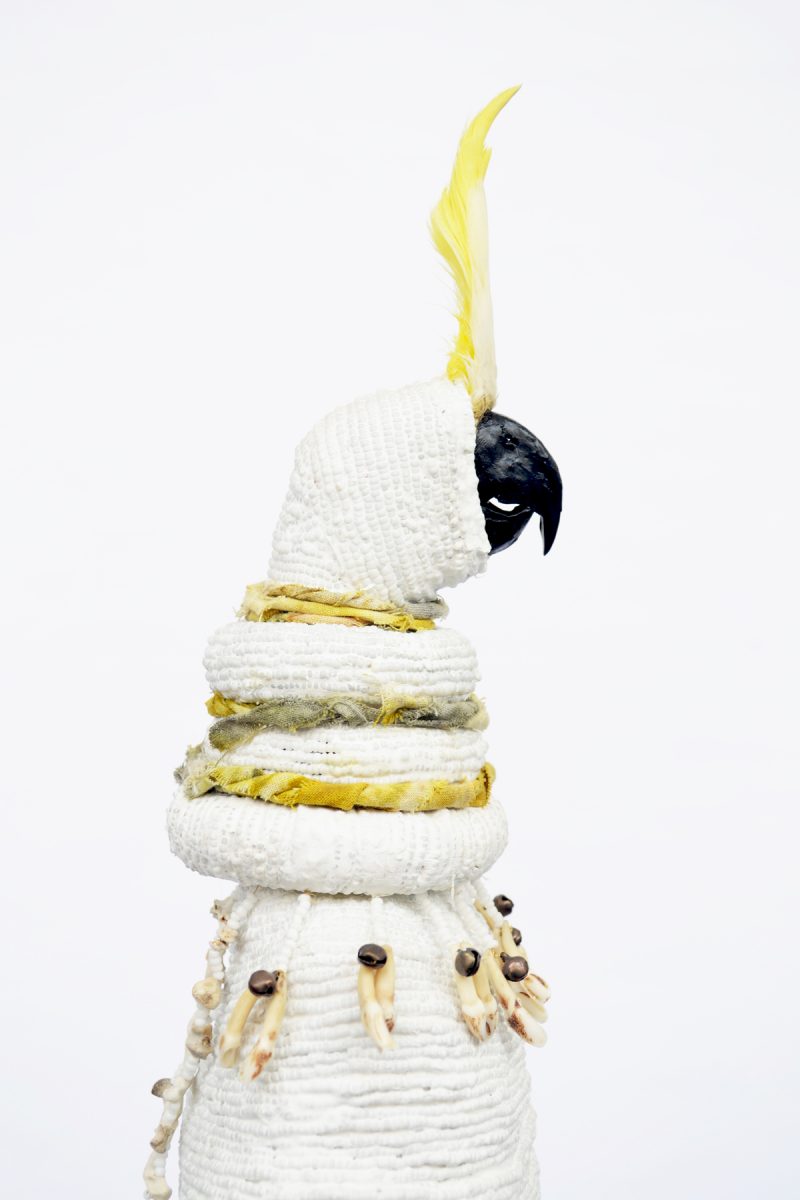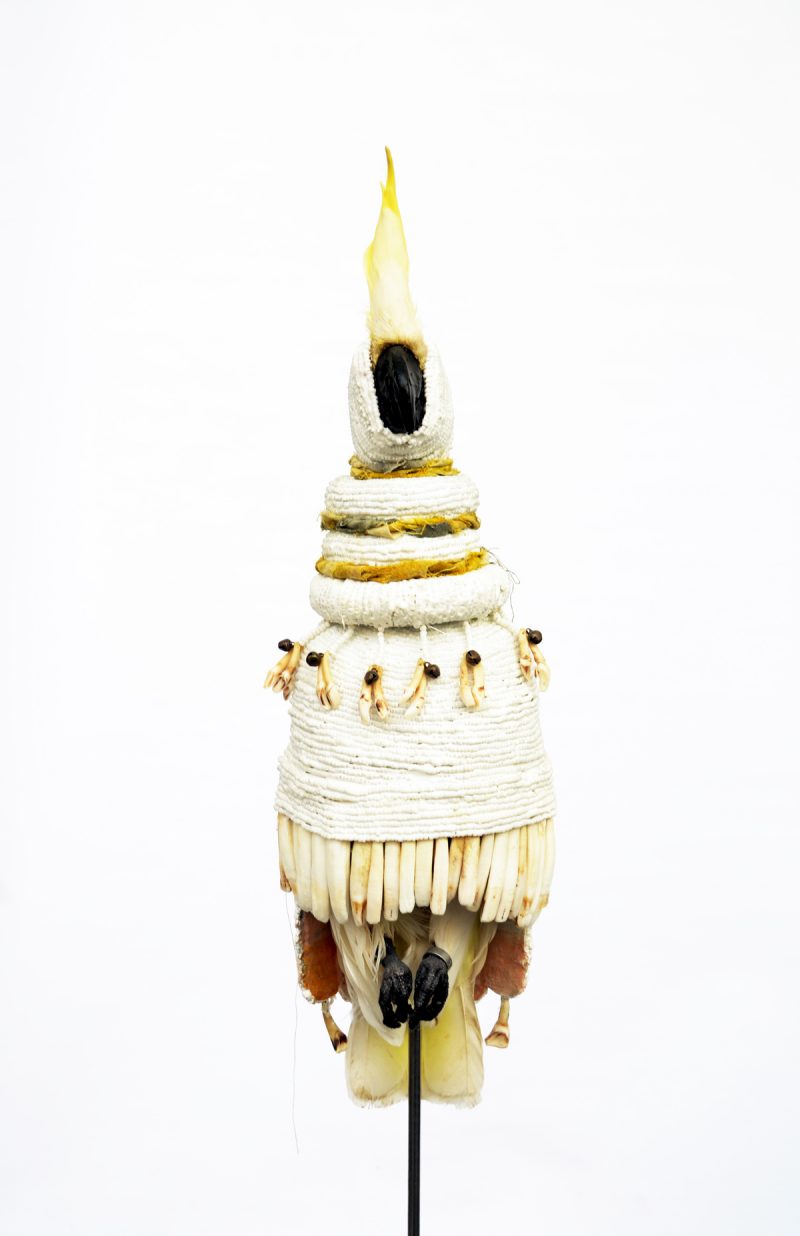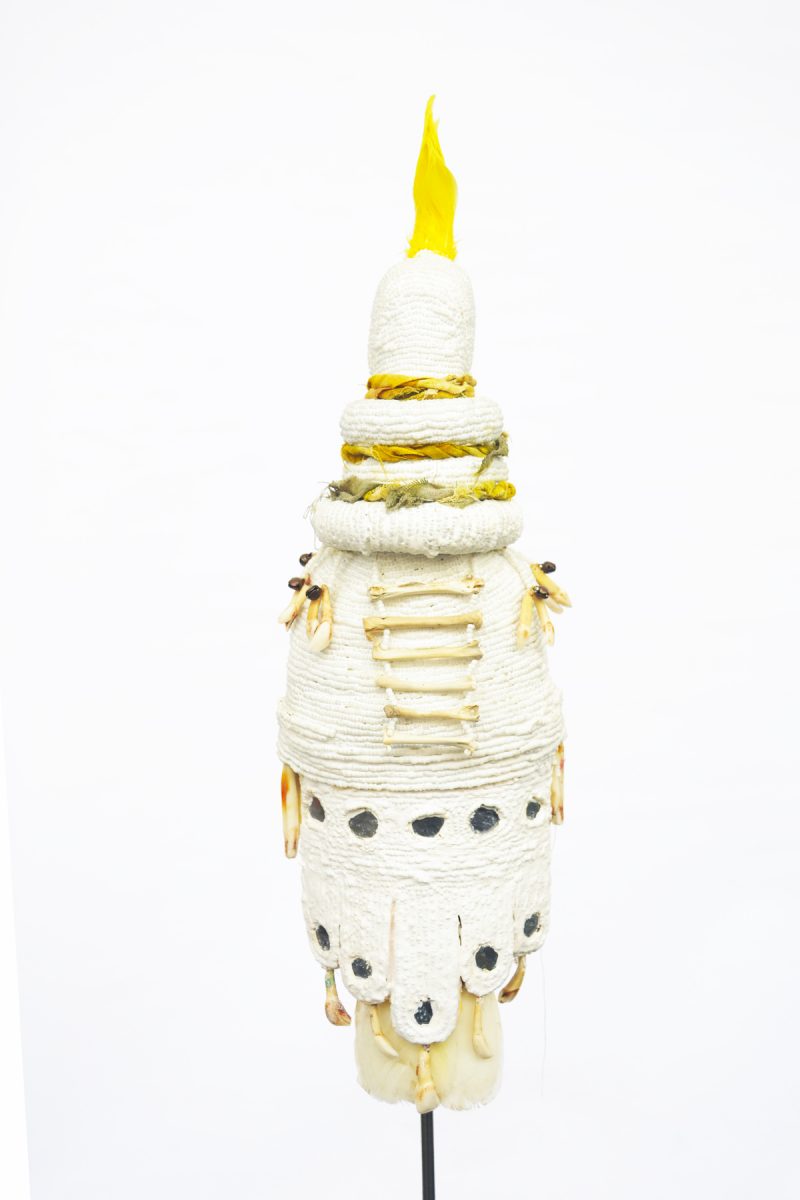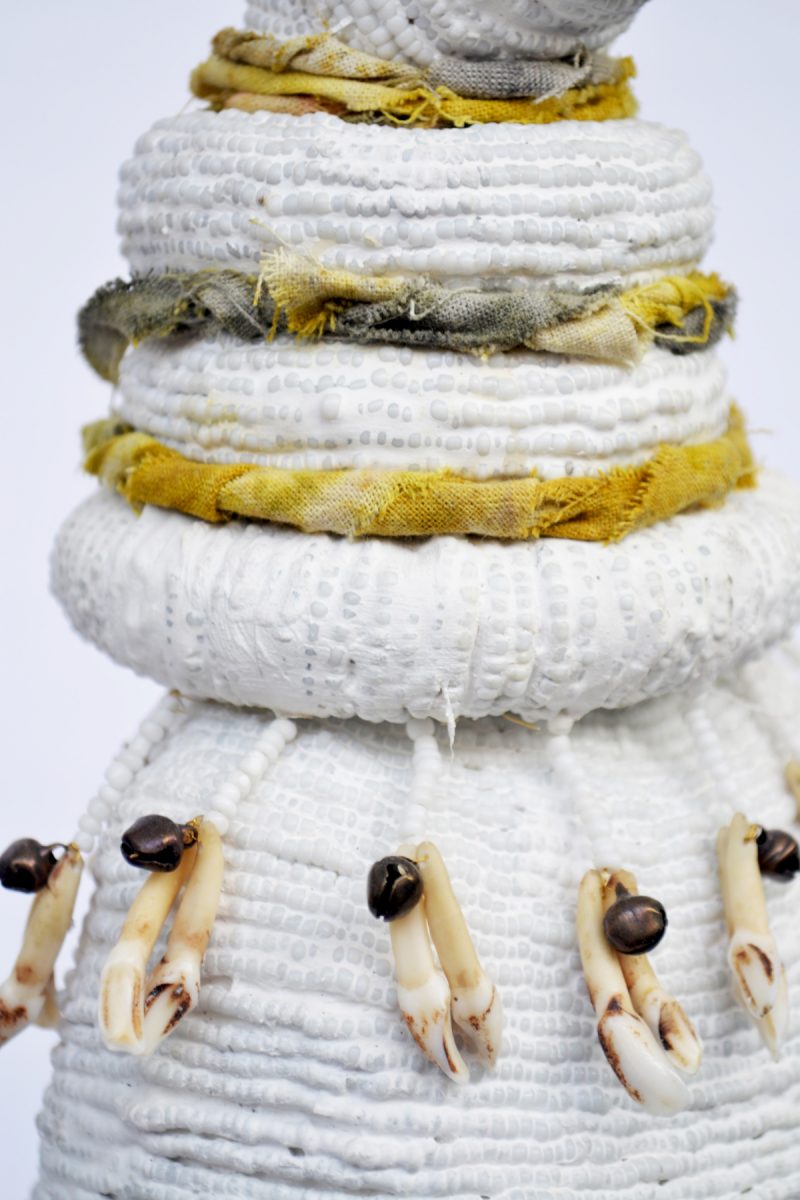Rowan Corkill, London, England, Cockatoo. 2017
Rowan Corkill (London, Englsand). Vigilant Things – Cockatoo. 2017-18. Taxidermy Umbrella Cockatoo, Beads, Deer Teeth, Boar Tusks, Small Bones, Bells, Fabric. Animal died of natural causes, ethically sourced in the United Kingdom. Collection of Guy Berube. Gift from the artist.
Rowan Corkills artistic practice is focused around mankind’s relationship with nature, both past and present. The artists research is centred on the ethnographical exploration of different cultures and civilisations, many of which are firmly rooted in a deep relationship with nature. By exploring different cultures, the artist has been able to learn how the human species has understood and interpreted nature over thousands of years through complex mythologies and symbolisms. This seems ever more prominent in a world where science and technology are at the forefront of our gaze, with the natural world becoming increasingly distant and our relationship with nature slowly dissipating.
Materials play a strong role in the artists practice, particularly the use of animal and plant materials which are collected and used in most of his works. Animal hides and skins are incorporated into sculptural works through taxidermy techniques which the artist has practiced for over 10 years. These taxidermy pieces do not fit within standard notions of the art form, instead of favouring the realism of Victorian taxidermy his works draw more from ethnographical objects such as African Nkisi objects or Nagaland head trophies. The use of taxidermy in his work acts as a foundation on which to apply materials, most of which are imbued with symbolic meanings which elevate the objects beyond the norms of the everyday. It is these symbolic references which cultures have applied to almost every facet of the natural world that drives the artist to explore new materials and provides him with a never-ending appreciating for both nature and mankind’s creative interpretations of it.
The works which Rowan Corkill creates posse a sense power as well as fragility, a duality which echoes that of the natural world. In recent sculptural works the artist has explored the protective qualities of materials, both physical and symbolic. The idea of protection has been one of mankind’s most prominent desires from the beginning of time and has manifested its selves in ritualistic objects around the world. Nature often acts as an intermediary between man and the spirit world beyond and It is in these instances that we can truly see the power and respect that nature once held over mankind.
NO ANIMALS WERE HARMED IN THE MAKING OF THESE WORKS.
Exhibitions List:
Solo exhibitions:
2016. The Seeker. 139 Artspace. Greenwich. London
2015. Ablutio. La Petite Mort Gallery. Ottowa. Canada
2013 Nigredo. Format Gallery. Milan. Italy
2010 Image after Memory. Project Slogan. Aberdeen. Scotland.UK
2009 BankStreet Gallery Presents. Kirriermuir. Scotland. UK
Group Exhibitions:
2017. Canadian Art & Danya Danger. Ottawa. Canada
2016. Evening at Le Petit Salon. Ottawa. Canada
2016. The Forewarned. Galleria Olinala & LPM Projects. Puerto Vallarta. Mexico
2015. Summa International Art Fair. LPM Projects. Madrid. Spain
2015. Keep me Posted. Art-Hub.London. UK
2015. Modern Panic. Guerrilla Zoo. London. UK
2015. Balak 3# Project Balak. Charleville-Mezieres. France
2014 The Grass Grows. Basel. Switzerland
2014 Antiritrato. Milan Photo Festival. Milan. Italy
2014 Hang Woman: The Arrested Feminine. Shwarts Gallery. London. UK
2013 The Others Fair. Turin. Italy
2013 London Calling 013. London.UK
2013 Hot One Hundred, Shwarts Gallery. London.UK
2013 The Catalyst Belfast Photography Festival. Belfast. Northern Ireland
2012 1 Minute Autohypnosis 11. Online project. Mute Sound.org
2012 Thank You for Creating London. CLR Projects. London. UK
2012 Hatched. Hatch Space Studios. London. UK
2011 Open Online. Fermynwoods. NorthHampton. UK
2010 DJCA Masters Show. DJCA Dundee. Scotland. UK
2010 Resonance FM ‘Experimental Orchestra’ Kill Your Timid Notion Festival, DCA. Scotland. UK
2010 Murmur Collective. DJCA. Scotland. UK
2009 The London Group Annual Show. London. UK
2009 The Tomorrow People. Hackney Wicked festival, Elevator Gallery. London. UK
2009 Society of Scottish Artists Annual Show. Vision Building. Dundee. Scotland.UK
2009 Postcards from the edge-Visual Aids. Metro Pictures. New York. America
2009 New Highland Graduates. Touring Exhibition of Highlands. Scotland. UK
2008 RSA Student Exhibition, Edinburgh. Scotland. UK
2008 Grays School of Art Degree Show. Aberdeen. Scotland. UK
2008 Project Wall Space, Montrose. Scotland. UK
2008 In Out, Feminist Today, Aberdeen University. Aberdeen. Scotland. UK
2008 Project Wall Space Christmas Show. Angus. Scotland. UK
2007 Margins- Limousine Bull Gallery. Aberdeen. Scotland. UK
2003/2004 Pittenweem art festival. Fife. Scotland. UK
2003 Group show- Lomond Art Gallery. Fife. Scotland. UK
2003 Glenrothes College Final Year Show. Fife. Scotland. UK
*
Abscission. 2016. Private Collection, Ottawa, Canada.
The Abscission series carries on from then Ablution works, reiterating the notion that man needs to find peace respect and a greater understanding of the natural world. Abscission is the process by which plants shed leaves each fall, removing the old before a regrowth of the new in spring. This act of rejuvenation is akin to resurrection or ablution, ridding oneself of sins and wrongdoings as an attempt to become a better person or worshipper. The human species must learn from abscission, to shed our wrongdoings and ignorance and re-grow a new and better understanding and appreciation for nature.
For millions of year’s plant life has provided mankind with shelter food and oxygen to breath. They have been used as vital ingredients in medicines which save millions of lives and create billions of dollars each year, yet we continually fail to provide a sustainable environment for plant life. The knowledge of plants healing properties have been passed down from indigenous cultures and lost civilizations across the globe. These people worshiped the natural world around them and lived in harmony with it, they understood the power and importance of plant life and even created gods from their presence. Unlike these civilisations, the western world has failed to truly appreciate the importance and power of plants with most people being completely ignorant to their importance in our everyday lives.
We happily consume and destroy plant matter without caring for their future sustainability and the effect that this will have on the natural world.
*
The Seeker 2014-2016. Permanently on display @ The Riviera, Ottawa, Canada.
Taxidermy deer head, wooden rosary crosses, beads, rope, fabric, metal.
“As the hart panteth after the water brooks, so panteth my soul after thee, O God.”
The stag as a symbolic reference to the Christian faith is arguably one of the most prominent and significant. It is a symbol associated with the soul’s desire for purification, piety, religious aspiration and longing. The stag represents the purest of faith within the human soul, it tells of the journey and path to finding faith as evident in the story of St. Eustace.
The purity and strength of the stag lends it to the greatest of all symbolism within the catholic faith, the symbol of Christ. The stag is a warrior of faith battling against the devil, an evil within nature as represented by the snake. The stag tramples the snake and destroys it with its breath of water triumphing over the devil and all the sins of nature.
Yet the snake is also the symbol of mother nature, the true creator of living things without sin or judgement. The snake represents the ground we stand on, the water we drink and the air we breathe. It represents the planet that mankind has been so quick to dismiss for heavenly ideals and aspirations.
‘The Seeker’ is both a representation of faiths power and its potency. It questions the relationship that certain belief systems have had with nature, and the way in which it has often been disregarded or wrongly accused. The stag represents a nature that has been shrouded by beliefs masking the power of true creation. It is not faith that we seek but nature itself.
*
The Trickster (Hares Heads with custom ceramic bases). Permanently on display @ The Riviera, Ottawa, Canada.
The Trickster acts as both a conjurer of spirits and a catcher, it is an object of superstition which takes from various global ideas surrounding such beliefs. It is also an exploration into the unusual coupling of ceramics and taxidermy.
Hidden talismans and symbols on the vessel act to conjure and attract dark spirits whilst the circular mirror acts as a catcher. This idea of spirit catchers originates from Old English Witches’ Bottles that were placed at the entrances to homes as a protection against evil. The use of mirrors is prominent in African cultures where it is believed that looking into mirrors catches the soul. The hare-head stopper is taken from Egyptian Canopic jar lids which reperesented different gods depending on the organs they contained. The Hare is often symbolised as the trickster having dual symbolism of good and evil. In many European countries the hare is believed to be a witch’s familiar as well as a positive symbol of fertility, changing of seasons and the moon. It is this double symbolism of good and evil that makes the hare and the vessel a perfect match.
*
Vigilant Things (Eider Duck with Porcupine Bodice). Permanently on display @ The Riviera, Ottawa, Canada.
Vigilant things are reliquary object to nature, they are creatures adorned with materials from the natural world in similar resemblance to the Catholic relics of saints, only without the excesses of grandeur and superiority. The materials used hold their own symbolic references stemming from global and cultural beliefs that are often created from deep understandings and connections with nature. The materials present in the pieces often become just as important as the animal since they are all created from and connected to nature. The symbolic references of the materials also transform the objects into powerful totems holding protective properties through the use of quills or thorns, or the inclusion of bells and other sound-bearing materials allow for these objects to have shamanic properties, becoming instruments with which to navigate the afterlife.
Vigilant things are not only venerations of nature but they are a representation of mankind’s connection with the earth and our connection with our own history as a civilization



